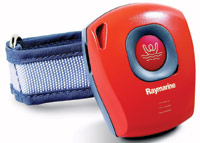The cry of "man overboard!" is second only to "fire on shipboard!" as a general alarm for all hands. But what if no one sees that fellow boater or shipmate (or pet) fall into the drink? The Raymarine (www.raymarine.com) LifeTag system, using Ember's ZigBee (www.zigbee.org) networking technology, does away with that unhappy scenario.
 Detect and locate an overboard boater |
LifeTag consists of a base station and wearable tags, which can be fitted around an arm or attached to a belt. The tags transmit wirelessly to the base station. If a person or a pet falls overboard, immersion in saltwater rapidly degrades the signal and triggers an alarm that alerts the rest of the crew. An alarm is activated as well when the wearer of a tag moves beyond 30 ft. of the boat, and can also be manually deployed by pressing and holding a red button for 3 s.
The base station handles communication with each of up to 16 LifeTags and provides outputs for external alarm sirens and relay contacts. It also speaks SeaTalk, Raymarine's interdevice communications network that enables it to activate the man-overboard mode on Ray-marine's multifunction displays to help quickly locate the missing person. The devices can operate a year or more on a single lithium battery (more than 200 operational hours).
The LifeTag System is the first commercially available product to use Ember's EM250 ZigBee system-on-a-chip and EmberZNet ZigBee-compliant networking software. And the LifeTag device took less than 50 days to create. According to Kieran Breheny, director of engineering development at Raymarine, "The nature of ZigBee makes it an ideal wireless standard for our LifeTag man overboard system. Ember's complete ZigBee platform and integrated tools enabled us to meet an aggressive product development cycle time."
Contact Ravi Sharma, Ember Corp., Boston, MA; 617-951-1236, [email protected], www.ember.com .
